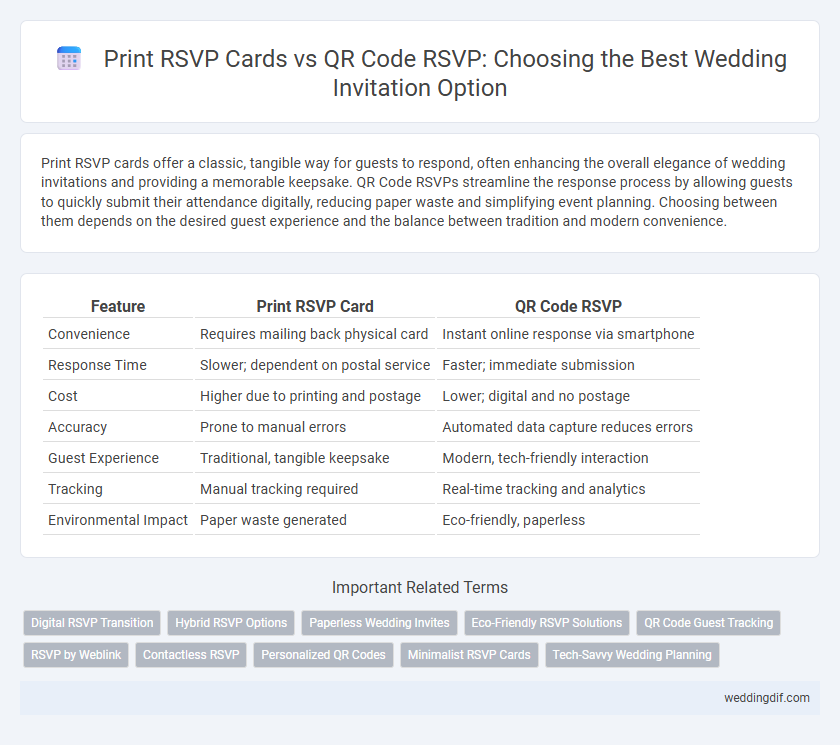Print RSVP cards offer a classic, tangible way for guests to respond, often enhancing the overall elegance of wedding invitations and providing a memorable keepsake. QR Code RSVPs streamline the response process by allowing guests to quickly submit their attendance digitally, reducing paper waste and simplifying event planning. Choosing between them depends on the desired guest experience and the balance between tradition and modern convenience.
Table of Comparison
| Feature | Print RSVP Card | QR Code RSVP |
|---|---|---|
| Convenience | Requires mailing back physical card | Instant online response via smartphone |
| Response Time | Slower; dependent on postal service | Faster; immediate submission |
| Cost | Higher due to printing and postage | Lower; digital and no postage |
| Accuracy | Prone to manual errors | Automated data capture reduces errors |
| Guest Experience | Traditional, tangible keepsake | Modern, tech-friendly interaction |
| Tracking | Manual tracking required | Real-time tracking and analytics |
| Environmental Impact | Paper waste generated | Eco-friendly, paperless |
Introduction: The Evolution of Wedding RSVP Methods
Wedding RSVP methods have evolved from traditional print cards to digital solutions like QR code RSVPs, reflecting advancements in technology and changing guest preferences. Print RSVP cards offer a tangible, classic touch that complements formal invitations, ensuring clarity and ease for less tech-savvy guests. QR code RSVPs streamline the response process, enabling instant, paperless replies and real-time tracking, enhancing efficiency for modern weddings.
Benefits of Traditional Print RSVP Cards
Traditional print RSVP cards offer a tangible and personal touch that enhances the overall wedding invitation experience. They provide a keepsake for couples and guests, adding sentimental value while ensuring responses are easily categorized without reliance on digital devices. Print cards also eliminate technical barriers, making it accessible for older or less tech-savvy invitees to respond promptly and accurately.
Advantages of QR Code RSVP for Modern Weddings
QR Code RSVP cards streamline guest responses by enabling instant digital replies, reducing paper waste and manual data entry errors. They enhance convenience for tech-savvy guests, allowing quick access via smartphones and real-time tracking of attendance. Integrating QR codes into wedding invitations supports eco-friendly practices and efficient event planning management.
Personalization and Aesthetics: Printed Cards vs. Digital Design
Printed RSVP cards offer a tangible, elegant touch that enhances wedding invitations with personalized designs, embossing, and textured paper, adding a timeless aesthetic appeal. QR code RSVPs provide a sleek, modern alternative that can be customized with digital graphics and interactive features but may lack the tactile charm and warmth of printed materials. Couples seeking a blend of tradition and personalization often favor printed cards for their ability to convey a sense of formality and attentiveness to detail.
Guest Experience: Ease of Use and Accessibility
Print RSVP cards offer a tangible and familiar option for guests, providing clear instructions that require minimal tech skills, enhancing accessibility for older or less tech-savvy attendees. QR Code RSVP systems streamline the response process by enabling instant digital submissions via smartphones, which can improve accuracy and speed while reducing paper waste. Balancing traditional print invitations with QR codes caters to diverse guest preferences, ensuring an inclusive and user-friendly response experience.
Tracking Responses: Manual Management vs. Real-Time Updates
Print RSVP cards require manual tracking of guest responses, often leading to delays and potential errors in managing attendance data. QR Code RSVPs enable real-time updates, allowing couples to monitor responses instantly through digital platforms and adjust wedding plans efficiently. Integrating QR Code RSVP systems enhances accuracy in tracking and reduces administrative workload compared to traditional print methods.
Environmental Impact: Paper Usage vs. Digital Solutions
Print RSVP cards require significant paper consumption, contributing to deforestation and increased waste during wedding preparations. QR code RSVPs eliminate the need for physical materials, reducing the carbon footprint and supporting sustainable event planning practices. Digital solutions also facilitate easier tracking and updates without additional environmental costs.
Cost Comparison: Printing Expenses vs. QR Code Setup Costs
Printing RSVP cards for weddings typically incurs higher upfront costs due to paper, ink, and postage expenses, especially for large guest lists. QR code RSVP systems require minimal printing costs but may involve setup fees for digital platforms or subscription services. Overall, digital QR code RSVPs offer a more cost-effective solution by reducing printing and mailing expenses while streamlining guest responses.
Etiquette and Tradition: Honoring Formal Wedding Invitations
Print RSVP cards maintain classic wedding etiquette by offering a tangible, formal response method that honors traditional invitations. They convey respect and thoughtfulness, aligning with the timeless tone of formal weddings and allowing guests to engage in a deliberate, meaningful way. QR Code RSVPs, while modern and efficient, may be perceived as less personal and can challenge the expected decorum of a traditional wedding invitation suite.
Choosing the Right RSVP Method for Your Wedding
Print RSVP cards offer a tangible, elegant touch that complements traditional wedding themes and ensures guests without smartphone access can respond easily. QR code RSVPs streamline the reply process, enabling instant online confirmation and reducing manual tracking errors, ideal for tech-savvy couples. Selecting the right RSVP method depends on guest demographics, wedding style, and desired convenience, balancing classic charm with modern efficiency.
Print RSVP card vs QR Code RSVP for weddings. Infographic

 weddingdif.com
weddingdif.com